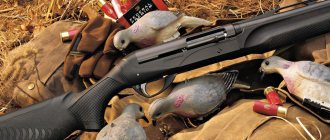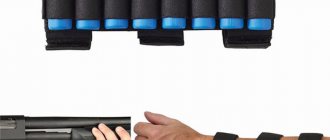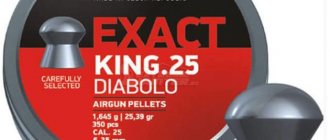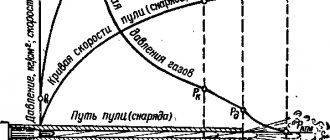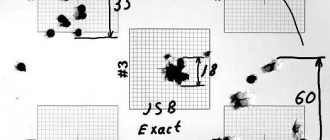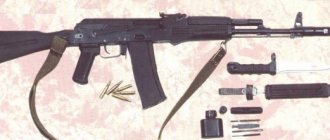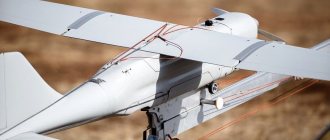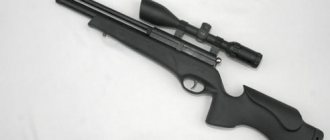Good bullets for hunting are developed and produced not only abroad, but also in Russia. The effectiveness of domestic bullets is appreciated by many hunters and, at times, they prefer them to their foreign counterparts.
As an example, we can cite the VVOO-Ilyin bullets, which are not only not inferior to the famous Brenneke bullets, but in some respects even surpass them. Or take the famous “Vyatka”. Despite the fact that the characteristics of these bullets are imperfect, many hunters prefer the Vyatka.
And now - a short excursion to get acquainted with different types of bullets for smoothbore guns. You will see that domestic gunsmiths do not lag behind their Western colleagues.
Introductory information
The bullet is usually used for hunting large game. And this is not surprising, because only a very skilled shooter can try to shoot a flock of ducks with their help. What is included in a regular bullet? Typically this is:
- Sleeve. It can be metal, cardboard, plastic, wood fiber and have a wide variety of diameters.
- Primer-igniter.
- Projectile.
- Wads.
- Charge of gunpowder.
When choosing bullets for hunting weapons, you have to take into account a lot of features. It is advisable to focus on a number of important indicators. In order not to resort to completely spherical data, 12 gauge was chosen as the basis. It is very versatile and allows you to hunt both large and small game, being a true embodiment of the ideal.
Important Features
It is necessary to take into account:
- Type of gunpowder. It can be smokeless/smoky. In general, it does not significantly affect shooting, although it may cause some discomfort.
- Sleeve type. The capabilities of the weapon used should be taken into account. For example, metal casings are more convenient and reliable, although they are expensive, and can also heat up during a shot.
- Price. This is influenced by the materials used, product quality, power, and the name of the manufacturer.
When you are interested in the best 12 gauge bullets for hunting, a smart decision would be to go with products from well-known companies. This is done in order to minimize the possibility of purchasing low-quality ammunition.
Why is it necessary to look at the caliber?
Many hunters do not always understand the significance of this moment. But in vain. Hunting an elk with the caliber of a fox will only allow you to wound the animal, which will rush to run with all its might. And it’s good if you manage to find him a few kilometers away and finish him off. In addition, economic considerations must also be taken into account. After all, more powerful ammunition tends to be more expensive. In addition, we should not forget about the weight of the projectile. It should also be noted that small cartridges have better flatness. This allows you to more accurately hit the desired target at considerable distances, even in adverse weather conditions. But enough general information. Next we will consider bullets for smoothbore weapons.
For smoothbore weapons
Hunters are primarily interested in different types of bullets for smooth-bore weapons. All existing products are divided by size - from 410 to 12 gauge. Of course, a 410 caliber bullet is much smaller than a 12 caliber bullet.
In addition, they can all be divided into two groups - caliber and sub-caliber. The first ones are slightly larger in size - they practically coincide in diameter with the trunk. This provides more weight and therefore more power. In addition, since they are practically adjacent to the walls of the muzzle, the powder gases exert greater pressure on them, accelerating them to the appropriate speed. But they are not suitable for barrels that have a choke - the barrel can simply inflate after several such shots.
Therefore, special types of bullets for guns were created - sub-caliber ones. They are slightly smaller in size, but easily pass through the muzzle constriction without causing the slightest harm to the weapon. For a long time, the downside was the fact that some of the powder gases bypassed the bullet, since it did not block the barrel. Because of this, power was partially lost. But today such bullets are usually supplied in plastic containers. They compensate for the smaller dimensions when passing through the barrel, while being easily deformed and not damaging the weapon.
However, plastic containers are also used for caliber bullets. Some of them have a special tail unit that allows them to stabilize the flight of the bullet and ensure maximum accuracy when shooting at extreme distances.
In general, there are a variety of different types of weapon bullets. Their form varies greatly, as does their specialization. For example, some show better performance when shooting at short distances, providing a more powerful stopping effect. Others are good specifically when shooting at a decent distance - from 100 meters or more. Bullets Polev, Brennecke, Sputnik, Foster, Mayer, Blondeau, Vyatka, Kirovchanka and many others - all of them have gained recognition among experienced hunters due to their excellent characteristics. As you can see, there are different types of bullets - the photos given in the article demonstrate this very clearly. Each product has certain pros and cons, which you definitely need to know about before choosing a specific ammunition. Better yet, check all those available at different distances. Then each shooter will be able to choose exactly those types of smoothbore bullets that he considers most suitable for himself.
Difference in design
Depending on the design, there are:
- Round bullets. For them, the statement is true that the diameter is equal to the caliber of the barrel. They can only be fired from cylinders. Round bullets are characterized by light weight and low stability in flight. True, the product is very cheap and can be made by a hunter without any problems. But it is always necessary to reject irregularly shaped shells. After all, an oval bullet, when fired, can jam in the barrel and lead to its swelling or even rupture. The use of such ammunition in raid hunts is prohibited. Well suited for firing at a distance of up to sixty meters. In addition, they have a good stopping effect.
- Arrow bullets. Typically made from a cylindrical, heavy head with a rounded tip and slanted or straight outer ribs. A light felt or polyethylene shank is usually attached behind. Although this is not always the case. They have a fairly reliable lethality when meeting a large animal at a distance of fifty meters. It is important that they are made with high quality.
- Turbine bullets. Usually made only from lead. They have a similar design as in the version discussed in paragraph 2. They have good shooting accuracy, although they cannot boast of good lethality. This is due to the fact that they quickly lose speed in flight.
- Arrow-turbine bullets. Typically distinguished by a body and shank made of lead. Moreover, their design is such that the bullets begin to rotate from the oncoming air flow. The shank serves to give greater stability in flight.
Arrow-turbine bullets
To achieve high shooting accuracy, it is necessary to make the bullet as stable as possible during flight. This can be achieved by applying low aerodynamic fins placed in a spiral, or blades on a stabilizer shank. This technological solution, together with the use of the arrow principle, became the basis for the production of this modification of 12-gauge bullets.
Caliber arrow-turbine bullet "Gualandi"
Brenneke bullet
This model was created at the beginning of the 20th century in Germany. It has become widespread throughout the world for smooth-bore weapons. The Brenneke bullet has angled ribs that cause it to rotate when fired. Belongs to the caliber category. This means that the containers do not interfere with the contact between the inner surface of the weapon barrel and the ribs themselves.
With this model it is possible to kill almost any large wild animal, even a grizzly bear. In comparison with the Poleva model, it has a significant drawback - the shot accuracy is worse.
Magnum cartridges
Very popular among hunters. A distinctive feature of these ammunition is that the bullets have increased ejection energy. The reinforced composition and increased power provide greater lethality. With such ammunition you can safely hunt large animals. The sleeves can be 76 and 89 millimeters long. True, not all hunters consider the Magnum an effective cartridge.
Bullet "Vyatka"
Widely used in making DIY ammunition. A common practice is to mount the bullet directly onto the gunpowder. Although the cautious prefer to additionally use sawdust. Its weight is considerable - it is as much as 35.2 grams. If you are interested in such a hunting bullet, then equipping it is not difficult. But if there is no practice in this matter, then it is better to turn to store-bought options. Next, we'll briefly look at how to do this.
So, making the Vyatka-2 bullet:
- It requires a primer (“Euro” is quite suitable), a twelve-gauge plastic sleeve, gunpowder (it is recommended to pay attention to TAKHO) in the amount of 1.9 grams, a gasket for “plate” type gunpowder, a greasy wood-fiber wad, sawdust and itself projectile
- The first step is to deal with the capsule. Gunpowder is poured onto it. The membrane is installed. Then sawdust. They are necessary in order to place the bullet at the level of the top edge.
Turbine type bullets
Inside the bullet there is a channel with ribs located obliquely. The ribs give it rotation. As a result, turbine bullets have good ballistic characteristics. It is worth paying attention to the Ideal bullets and the development of the Sokolov brothers. The latter have a channel in the form of a ring between the casing and the core. The presence of this channel allows you to equip the bullet with a wad-stabilizer. But there are still shortcomings. Thus, cartridges must be loaded carefully, and “Ideal” bullets are not suitable for loading brass cartridges. Russian turbine-type bullets have a complex shape, and their casting is not always of high quality. Some hunters fine-tune their bullets themselves, but this takes time.
On our website, in the section with cartridges, you can buy modern bullets “Strela”, Gualandi, Zala and others. The choice is quite large. Thus, 12-gauge cartridges with B&P bullets weighing 26, 28.29 and 32 grams are available for sale. And Polev’s bullets are presented in 2 versions. Poleva 1 and 2. Cartridges with Gualandi bullet for 20 caliber smoothbore shotguns. There are “Combi” bullets from If you haven’t decided yet, you can try cartridges with different bullets, and then choose exactly what you like best.
Puli Poleva
This is good ammunition. This hunting bullet is recognized in the countries of the former Soviet Union. It got its name from the name of the designer - V.V. Polev. This is a arrow type of bullet. They contain a lead striking element with a plastic shank. Their head part is equipped with plastic containers, which are separated after leaving the barrel. This was done to ensure better cross-country ability along the gun channel. The design proposed by Polevoy has proven itself well in cases where it is planned to hunt elk, wild boar, bear - that is, large game. Its use allows you to effectively hunt the animal. It has a number of undeniable advantages:
- Allows you to confidently hit a target at a distance of up to 100-150 meters.
- Has excellent speed.
- Characterized by a high level of muzzle energy.
Thanks to this, it is considered the best among all domestic products. However, it should be noted that it also has certain disadvantages:
- Low weight, in the range of 28-29 grams, while other manufacturers offer products weighing 32 g. Because of this, the lethality is reduced.
- Low level of stabilization. Because of this, the bullet can deviate greatly from the intended trajectory, even in the presence of small obstacles.
- Complex shape. It does not allow high-quality production of such bullets at home.
It should be noted that this is a relatively new development. The first option was proposed in the 1980s.
Arrow bullets
From the name it is clear that an arrow shape was used for this type of construction. All models are equipped with a lightweight tail, which serves to stabilize them during flight. Due to the fact that the front part is made heavier compared to the back, it has a clear shift in the center of gravity towards the head. This affects the correct flight and prevents it from turning over.
Polev's bullet
The Polev bullet was created in the 80s in the Soviet Union. It is a striking element made of lead of small diameter, which is mounted on a plastic shank. In addition to the shank, the diameter of the bullet requires a special thick container for firing. This is necessary so that, unlike usual, it does not dangle. Due to these requirements, the Polev bullet is quite difficult to make on your own.
Used for hunting large animals: bear, wild boar, elk. There are steel and brass variations, but they are practically not common.
A distinctive characteristic of the model is decent accuracy at long and fairly long distances for a smoothbore gun. Up to 150 meters can hit the beast outright. However, the bullet is not suitable for shooting through thickets or bushes due to strong deflections when hitting even minor obstacles.
VVOO-Ilyin bullet
A domestically produced model, which has two parts: main and tail.
The main one is made in the shape of a monolithic cylinder and has a conically pointed appearance in front. Flat ribs are located along the axis of symmetry. The design also provides for a guide belt. The tail section has a lightweight polyethylene three-bladed stabilizer.
Practice has shown that it is the weakest link in the design of this model. It is so weak that during a shot it completely flies off under the influence of the impact force of the powder gases.
This directly affects the deviation of the bullet from the planned flight path.
Bullet Vyatka
This model is also composite in its structure. In appearance it resembles a drop. The model is equipped with 6 ribs that ensure its centering. The design of the model is quite compact and streamlined.
Bullet Diabolo Liman
The model is similar in appearance to match pneumatic bullets. Very famous among hunters who like to shoot for accuracy. The model belongs to the sub-caliber category. Its design ensures a low percentage of rebounds.
The model is easy to make at home, since quite a few manufacturers produce overclocking quality watering cans. The presence of this tool and simple design allows you to make a lot of Diabolo Liman pieces. Therefore, this type is better suited for hunters who like to shoot a lot and often.
Brenneke bullet
This is a German product. Many praise them as such, which is of high quality. The manufacturing company gained popularity more than a century ago thanks to the inventor Wilhelm Brenneke. He was able to create a bullet that is still widely used for shotguns today. There is lead in its head part. Behind him is a felt wad. Bullet weight for 12 gauge ranges from 30 to 32 grams. At this time, ammunition is produced with different energy levels and for different calibers. But the production scheme is practically unchanged. The most advanced variants of bullets are those equipped with plastic stabilizers. They are characterized by excellent speed and stability of the intended trajectory. Among the advantages worth mentioning:
- High accuracy.
- Excellent stabilization, even if grass or branches are touched during flight.
There were some drawbacks:
- Difficult to manufacture due to its intricate shape and composition.
- In addition, additional components are required (stabilizers of a certain shape, bolts). Therefore, if minor flaws were made in production, this greatly affects the quality of the resulting ammunition.
Rubeykin's bullet
O. Rubeykin developed a “coil” shaped bullet. It is similar to Blondeau's design, but the center of gravity is located closer to the head. Suitable for manufacturing are brass, steel or copper. Due to the lack of a lead belt, you have to use a plastic container to make the bullet move better in the barrel of a hunting rifle.
Rubeykin's bullets fall tightly, and they have a good lethality. But there is one drawback - the holes have low longitudinal stability. Well, the plus is the simplicity of the bullet, which is simpler than its foreign “twin” - the Blondeau bullet.
Sheddit and Tahoe bullets
The first option is very popular among hunters. Their only drawback is their high cost. Since all elements are manufactured at one factory, this has a positive effect on the quality of ammunition. This hunting bullet is available in a large number of different variants. A cheaper analogue is the Tahoe ammunition. This is a very inexpensive option. It is characterized by stability of combat, as well as pinpoint accuracy of loading cartridges (if we are talking about store-bought products).
Jakana (Zhakana)
This hunting bullet was created in the Baltic states. This happened at the beginning of the last century. Developer: Yakanis. The Jacana has external ribs that stabilize its flight. This bullet also has wads in the shank. The center of gravity is shifted towards the hollow head. The head is filled with wax or covered with lead.
The zhakan has a peculiarity - when it hits the animal’s body, the bullet turns around, causing serious damage. This effect is achieved thanks to special notches on the body.
The zhakan also has its drawbacks - when it hits a branch, the bullet is deformed and changes direction of flight. The zhakana is also not suitable for shooting at a long distance. Nowadays, hunters rarely use such bullets. Their time has passed. But 30-40 years ago they were very popular.
Domestic "Glavpatron" and "Tehkrim"
The Tula plant supplies high-quality and reliable ammunition. It also attracts many hunters due to its low price. But it also pleases with its quality: high rate of fire and excellent stability. By the way, speaking about the large number of options, it should be noted that there is not a bit of understatement here - there really are a lot of them. For example, the “High Speed” model allows you to confidently hit targets at a considerable distance.
is engaged in the production of ammunition for traumatic and smooth-bore weapons. Their main advantage is the ideal price-quality ratio. The funds used to purchase their ammunition are well worth the cost.
SCM, Vetter and Record
Let's look at another group of domestic producers of high-quality hunting ammunition. Their products are safe to use, maintain a good level of accuracy with high projectile velocity, and are suitable for semi-automatic shotguns. Additionally, there is a wide range of products for every taste and choice.
Fetter is a well-established manufacturer. This brand is characterized by high muzzle energy. Therefore, in case of hunting in winter or targeted shooting at a short distance, this bullet is best suited.
Record has certain disadvantages. But due to its price, ammunition is in very high demand. Among the shortcomings, it should be noted the low sharpness of the battle. Although experienced hunters claim that they perform well at a distance of up to 35 meters.
Bullet "Kirovchanka"
The design of the Kirovchanka repeats the design of McElveen. Unfortunately, her fight leaves much to be desired. This is due to the poor quality of the bullet and its container. Due to the use of soft lead in its manufacture. There were attempts to modify the bullet, but all modifications were far from the quality of their foreign counterpart.
It should be mentioned that the famous McElveen bullet served as a prototype for another Russian bullet - the BMK. It was developed by three people - Bulavin, Medvedev, Komarov. The bullet is named after the initial letters of their last names. The BMK flies out of the barrel at high speed. It is stable in flight, which, of course, affects good accuracy.
And more about the choice of ammunition
What hunting bullets will be used is very important. Unfortunately, it is often impossible to understand all the features and subtleties using only one specialized literature. It is not uncommon for serious mistakes to be made. Active practice is required for good results. It is in this case that each hunter can experiment with different ammunition options and use them in different conditions. Thus, one has to take into account the types and types of the products themselves, the weapon used, caliber, firing density, accuracy, penetration, diameter, case material, type of game being hunted. At the same time, one should not forget about the terrain.
Easily destructible bullets
What stands out is an unusual type of bullet – easily destructible. Another name for them is controlled ballistics bullets. Such cartridges are intended only for rifled weapons, and are not supplied to the army or regular law enforcement agencies, as they are extremely highly specialized.
The product consists of a thin lead shell filled with very small shot - up to 200 pieces. A special plastic cap is used as a spout. Yes, the device is extremely unusual, but the bullet does its job perfectly.
When it hits solid objects, it simply crumbles, without ricocheting or damaging the surface. But if a bullet hits a body that is not covered by body armor, the cap is destroyed, the bullet itself is crushed and stops. But the smallest pellets go further, without causing the slightest scattering. As a result, they act almost the same as a bullet, only they cause even more damage, destroying internal organs, causing profuse bleeding and causing extreme pain. Such bullets were developed for special services responsible for the safety of passenger air travel. The most famous are the so-called air marshals.
They use special cartridges that allow them to reliably destroy any enemy not covered by body armor or other protection. But at the same time, if the shooter misses, the bullet will not pierce the aircraft’s skin or ricochet, causing damage to surrounding people.
There is also a modification of the bullet that allows you to fire through light obstacles, for example, the backs of passenger seats. They still retain a high wound impact, but do not ricochet and are not capable of penetrating the skin of the aircraft, leading to depressurization of the cabin.

